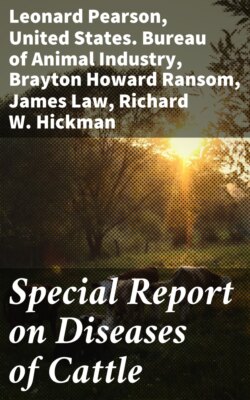Читать книгу Special Report on Diseases of Cattle - Lowe - Страница 61
На сайте Литреса книга снята с продажи.
MINERAL POISONS. ARSENIC POISONING.
ОглавлениеOf the common irritant and corrosive poisons, arsenic, especially one of its compounds (Paris green), is likely to be the most dangerous to our class of patients. The common practice of using Paris green and other compounds of arsenic as insecticides for the destruction of potato beetle and other insect enemies of the farmer and fruit grower has had the effect of introducing it into almost all farming establishments. White arsenic is also a principal ingredient in some popular dipping preparations, and poisoning from this source occasionally takes place when, after dipping, animals are allowed to run in a yard in which there is loose fodder. The drippings from the animals falling on the fodder render it poisonous and dangerous to animal life if eaten. Familiarity with its use has in many instances tended to breed contempt for its potency as a poison. Rat poisons often contain arsenic. The excessive use of arsenic as a tonic, or of "condition powders" containing arsenic, has been the means of poisoning many animals. This is the common poison used by malicious persons with criminal intent. The poison may also be absorbed through wounds or through the skin if used as a dip or bath.
If a large dose is given, at once acute poisoning is produced; if repeated small doses are given, chronic poisoning may result. The poisonous dose for an ox is from 3 drams to 1 ounce.
Symptoms.—The symptoms of acute poisoning first appear as those of colic; the animal is restless, stamping with the feet, lying down and getting up. There is tenderness on pressure over the abdomen. The acute symptoms increase; in a few hours violent diarrhea is developed; in many cases blood and shreds of detached mucous membrane are mixed with the evacuations. There is irregular and feeble pulse and respiration, and death is likely to supervene between the eighteenth hour and the third day. If the latter period is passed, there is a reasonable hope of recovery.
In chronic poisoning the symptoms are similar to those of chronic gastrointestinal catarrh, with indigestion, diarrhea, and general weakness and loss of condition.
Treatment.—The antidote for arsenic is a solution of hydrated oxid of iron in water. It should be prepared fresh by mixing a solution of sulphate of iron, made by dissolving 4 ounces of sulphate of iron in one-half pint water, with a suspension of 1 ounce of magnesia in one-half pint water. This quantity is sufficient for one dose for a cow and may be repeated in an hour, if much arsenic was taken. A solution of calcined magnesia or powdered iron or iron filings or iron scale from a blacksmith's forge may be given in the absence of other remedies. Powdered sulphur is of some value as an antidote. One must also administer protectives, such as linseed tea, barley water, whites of eggs, etc.
